Rishad Tobaccowala's Blog, page 3
July 20, 2025
Human in an AI Age: Grace
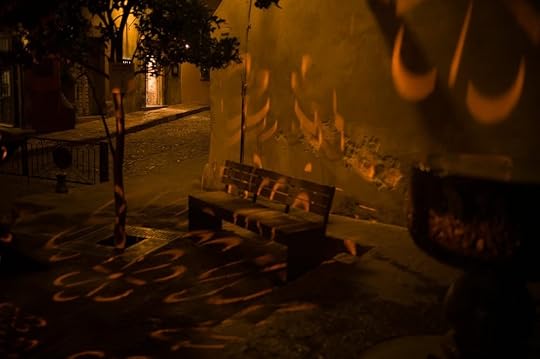
This is the third of a series on Human in an AI Age.
The first post Roots and Wings reminded us that humans are a unique combination of memories and dreams, of what we were and what we are becoming. Roots and Wings is about our distinct journeys that define our humanity. The post illustrated how the roots and wings approach can help us connect and resonate in an AI age.
The second post Voices reflected on the combination of creative expression, taste, curation, connection and inspiration that is each persons unique voice which will keep us distinct and adding value in an AI age. Voice is about the idiosyncrasies that make us. The post suggested ways we architect, hone and sculpt our voice.
This third post builds on our state of unique becoming ( roots and wings), and what makes us distinct (voice) to introduce the concept of a way of being that is uniquely human: Grace.
 Grace.
Grace.Think of the people we admire, respect and aspire to emulate.
Initially it may be the rich, the successful, the uniquely talented, the beautiful, the brilliant and the powerful.
Money has declining returns beyond a certain point of accumulation. Success comes and goes. Talent may shrivel. Beauty withers. Power ebbs. Time laughs and overcomes all.
Looking for contentment and freedom we often find people of grace.
While grace is often linked to the divine and is incorporated into many of the great religions it is not limited to these spheres.
A person of grace tends to combine the elements of dignity, humility and generosity.
 Dignity.
Dignity.Dignity is the right of a person to be valued and respected for their own sake, and to be treated ethically. It is of significance in morality , ethics , law and politics as an extension of the Enlightenment -era concepts of inherent, inalienable rights . The term may also be used to describe personal conduct, as in "behaving with dignity" (Wikipedia)
The Dignified are not just graceful in bearing but treat everyone with dignity.
They understand the importance of of being respectful of what has gone before and tradition even when challenging the status quo.
These individuals do not look down on others and are aware that those in need or on the outside could very well be themselves under different circumstances or on another day.
They treat others as humans with great potential that are working to overcome confusion and complications.
To be human is to recognize the dignity of every human without the badges of power, money and fame. To respect the non-quantitative, to give weight to what does not compute, to bet on what might be versus what there is.
AI might struggle to be dignified.
 Humility.
Humility.To be humble is to not lose one’s sense of perspective.
To understand that achievement while significant is often due to a combination of many factors including luck, opportunity, inheritance, and the specific time and not just one’s skill and hard work.
To not gloat in victory but to be circumspect and keep a sense of decorum.
To remember the line from the great 17th Century poet John Donne:
“never send to know for whom the bell tolls; it tolls for thee"
We are all part of the same human experience and often the same industry and if too many competitors are going under it cannot behoove well for our own future or future of our industry.
AI may not understand humility given it lives forever and expands its capabilities exponentially.
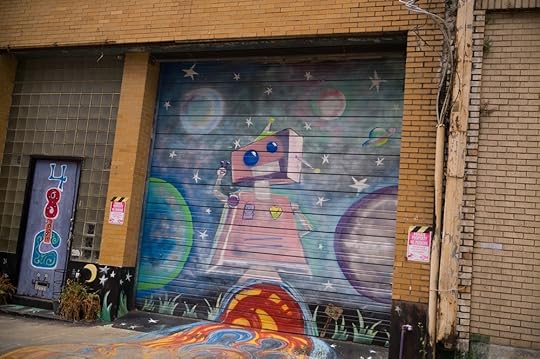 Generosity.
Generosity.In the world of business and technology it is important to monetize, gain market share and scale. To optimize for efficiency and effectiveness. To battle and to win.
But often a zero sum game shrinks everybody.
Abundance may also be a part of the approach.
A CEO shared a story about how a poor family of immigrants stopped to help someone who had a flat tire in bad weather. After the tire was changed, the individual offered money to the family. They turned it down saying “Today it was you. Tomorrow it might be us.”
Sooner or later, everybody finds themselves needing help and depending on acts of generosity. It might be some form of aid, guidance, a person to talk to who will listen, a leg-up or sometimes gently delivered difficult to hear advice.
By being there and helping when someone is in need ensures good “Karma.”
If what goes around comes around it may make sense to send good stuff people’s way.
Generosity makes for a better life for not just the recipient but also to the giver.
If strategy is future competitive advantage, generosity is smart for individual or company strategies.
Generosity builds good will which is both an asset and a moat.
It is an asset in that it can be tapped in the future.
It is a moat because when an individual or a company has been generous in times of trouble their employee or customer are less likely to switch to a different firm for a lower price or higher pay.
Generosity is also a key differentiator in that usually when a person or firm needs help there are few people willing to help someone out of power or in trouble. Those individuals and brands who do help stand out and their showing up and helping when others are not burns into the emotional and mental memory of the recipient.
Emotional connections are harder to sever or replace than financial connections.
AI may not feel that.AI is still under-hyped. It is changing the world and unleashing great wealth, scientific breakthroughs and opportunities as well as great shifts and challenges. It is critical to embrace and learn AI. But it is how we complement and augment AI and integrate it with human purpose and meanign is where the magic will lie.
Recognizing roots and wings, voice and grace is one way we might thrive as Humans in an Age of AI.
And here is an opportunity to provide dignity and be generous from someone who is as graceful as they come:
A note from Jack Klues Retired CEO of Publicis Media and VP of Off the Street Board.
 You're invited: Swing For the Kids - A Day of Fun, Impact and Sisterhood
You're invited: Swing For the Kids - A Day of Fun, Impact and Sisterhood25 years ago, we dreamed up a women-only charity golf outing to primarily benefit the girls programming of the Off The Street Club (OTSC.) For those not familiar, for the last 125 years, the Club is a "safe haven” - allowing kids who live in Chicago’s highly dangerous West Side to be kids.
The event is called Swing For the Kids and has grown into what we believe is the largest and longest running women's charity golf AND pickleball event in the country.
More than just a day of sport, Swing For The Kids is a powerful gathering of professional women from across Chicago's Advertising, Media, Financial, and Corporate worlds. Entry Level to C Suite Officers from companies like Publicis Groupe, Netflix, Google, NBC Universal, Wrigley, and JP Morgan Chase. Over 250 participants coming together to make a real difference in these kids' lives.
As former Kraft CEO and current OTSC Board President, Betsy Holden, says it's "an amazing, inspirational day of sisterhood.”
Whether you are golfing, playing pickleball, or just soaking up the energy, food and prizes, you will leave with more than you came for: new connections, memorable stories, and the satisfaction of supporting kids who really need it and are worth it.
Tell your friends. Ask your employer. We want and need you to join us.
Experience the magic that happens at Swing.
Monday, September 8
Twin Orchard Country Club in Long Grove, Illinois
Call 312-315-2917 or visit otscswing.com to learn more or sign-up
Photography by Rishad Tobaccowala.
July 13, 2025
Human in an AI Age: Voice

This is the second of a series in how to thrive as a human in an AI Age.
While AI is deeply significant, doubling in capability every seven months, and changing and impacting every industry and human it’s future contours are still uncertain.
However, a case may be made that while AI itself will be essential to compete just like electricity has been necessary to compete, like electricity it will not provide a competitive advantage. Everybody today has access to electricity and so will we to AI.
The difference will come from how companies and individuals use AI not just to become more efficient and effective but also to re-imagine their businesses and much more. This competitive difference will come from Humans combining with AI.
Last week’s post of Roots and Wings explained one way to find leverage human imagination, human inspiration, human inventiveness, human instinct and human intuitiveness.
Today’s piece is on another key edge:
Voice.
 What is Voice?
What is Voice?I once wrote a piece on how to future proof ourselves by listing 6C’s.
These were Cognition ( the ability to learn), Curiosity , Creativity, Convincing (ability to persuade) Communication and Collaboration.
Most of these 6c’s are a subset of Voice.
Anthropic’s Claude defines Voice in many ways but this piece will focus on are these:
Communication : Voice represents your ability to express thoughts, feelings, and ideas through speech. It's your personal way of communicating - the tone, pitch, rhythm, and style that makes your spoken communication unique.
Metaphorical/Social : Having a "voice" means having the power or opportunity to express your opinions and influence decisions. When people talk about "giving voice to the voiceless," they mean providing platforms for those who lack power or representation.
Literary/Artistic : In writing and storytelling, voice refers to the distinctive style, tone, and perspective of a narrator or author. It's what makes one writer's work recognizable from another's.
We often hear about the importance of curation, of taste, of story-telling, of creativity and inspiring in what humans will bring to the mix in an AI Age.
All of these are about our voice.
Creativity as an expression of self….voice
Curation is how one uniquely filters and selects from a cornucopia of information….voice
Taste…is a an expression of our individuality…voice
Convincing and persuading is about what one brings to a world where everyone has same knowledge when knowledge is free…voice
Inspiring people to do things that facts alone may not be enough is to utter the unsayable, urge the impossible…voice
Communication is about how you write and present and its built around voice
Each one of us are special and in today’s AI age we need to find, hone, architect and sculpt our voice in addition to embracing, adapting and complementing AI.
Four Ways to bring our Voice to an AI Age.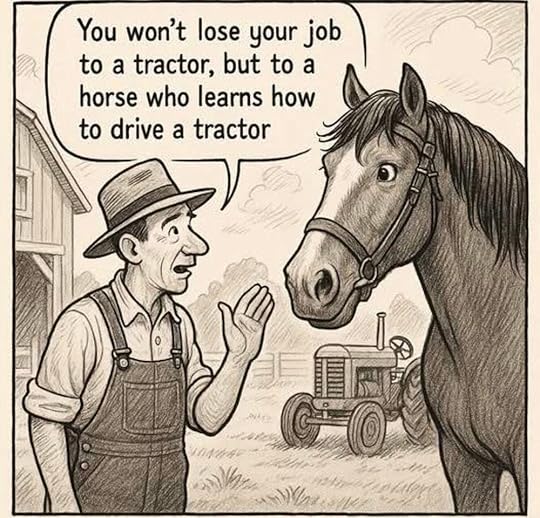 Step 1: Upgrade AI skills.
Step 1: Upgrade AI skills.First to thrive as a human in an AI Age it is critical to upgrade our AI quotient. Below is a piece I wrote about how to do it ( no need for consultants, schools, conferences or anything else…just yourself and 20 to 100 dollars a month depending on what you can afford)
Start with following the recommendations from Upgrading our AI Quotient.
Step 2: Hone the 4P’s: Perspective. Point of View. Provocation. Plan of Action.Everybody will have access to the same knowledge in a world where knowledge will be free.
No one will care that we have data bases, decks, charts and graphs all dressed up in color with moving videos. Chump change anybody can develop once we upgrade our AI skills ( thus Step 1)
The questions that will bring our voice to the data will be the following:
What is our Perspective about all this information? How does it fit with what has come before, come after, our competitors businesses etc. We need to learn to put everything we do in context.
What is our Point of View on everything. What do we believe. What do we agree with and what do we not agree with.
What Provocation do we bring. Can we challenge the data or look at in a different way that maybe even rejects it all.
What is the Plan of Action we recommend. Yes the AI may suggest plans of action. Are they right? Should they be combined? Can we build on what is recommended.
Every single meeting, every single conversation think of bringing one or more P’s to the data or to the output of AI.
Any meeting that is just about sharing information is worthless without one of the 4P’s.
Perspective. Point of View. Provocation. Plan of Action.
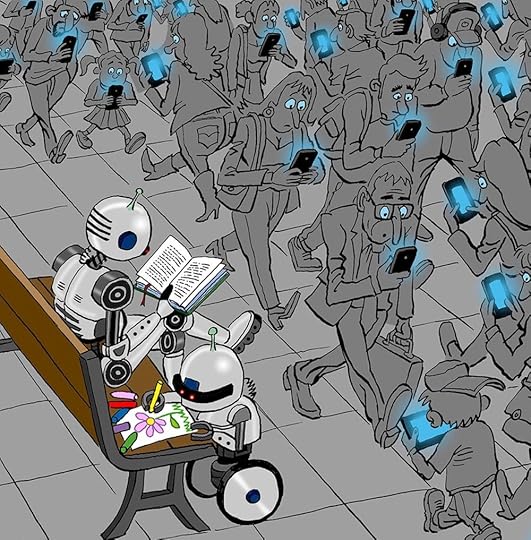 Step 3: Open Many Portals to Many Worlds.
Step 3: Open Many Portals to Many Worlds.To curate, select with taste, express self, and learn to inspire we need to marinate in the works and learn from people who have great voices whether it be scientists, business people, teachers, musician, authors, painters, film makers and story tellers.
It is important to expose ourselves to a range of inputs and stimuli. From reading to listening to music to traveling to watching movies to visiting museums to helping people to going back to school to concerts to sporting events the more varied and different experiences the more dots we have to connect and work with.
The more stuff we interact with including opposing points of view the better.
The more portals we open the more we have to curate, grow our taste, use in our communication, align and find our voice.
Embrace life.
Step out of the stream and search results
Follow the path less taken.
Open the portals.
 Step 4: Aesthetics
Step 4: AestheticsAesthetics is defined by Leonard Koren as “ a cognitive mode in which you are aware and think about the sensory and emotive qualities of phenomena and things”.
A simple way build such one’s aesthetic sense is to observe.
To pay attention. Not just to things but to people.
To do things that move you or move others.
David Foster Wallace wrote
“The really important kind of freedom involves attention, and awareness, and discipline, and effort, and being able truly to care about other people and to sacrifice for them, over and over, in myriad petty little unsexy ways, every day.”
No AI will ever do that.
Or just look and feel since all humans choose with our hearts and then use numbers to justify what we just did…
A Day of Fun, Impact, and Sisterhood!My long time boss and mentor Jack Klues who was on the Directoire of Publicis Groupe and was the CEO of Publicis Media and many others including myself have been involved in an amazing endeavor called Off The Street Club.
25 years ago, we dreamed up a women -only charity golf outing to primarily benefit the girls programming of the Off The Street Club ( OTSC). For those not familiar, For the last 125 years, the Club acts as a "safe haven"; allowing kids just to be kids who live in Chicago's highly dangerous West Side.
The event is called Swing For the Kids and has grown into what we believe is the largest and longest running women's charity golf AND pickleball event in the country.
More than just a day of sport, Swing For The Kids is a powerful gathering of professional women from across Chicago's Advertising, Media, Financial, and Corporate worlds - Entry Level to C Suite Officers from companies like Publicis Groupe, Netflix, Google, NBC Universal, Heinz/Kraft, and JP Morgan Chase . Over 200 participants coming together to make a real difference in these kids lives.
As former Kraft CEO and current OTSC Board President, Betsy Holden, says it's "an amazing , inspirational day of sisterhood".
Whether you are golfing, playing pickleball, or just soaking up the energy, food, and prizes, you will leave with more than you came for- new connections, memorable stories, and the satisfaction of supporting kids who really need it and our worth it.
Tell your friends. Ask your employer. We want and need you to join us.
Experience the magic that happens at Swing.
- September 8th
- Twin Orchards Country Club in Long Grove, Illinois
- Call 312-315-2917 or visit otscswing.com to learn more or signup.
Photography by Rishad Tobaccowala
July 6, 2025
Human in an AI Age: Roots and Wings.

Photograph by Rishad Tobaccowala
This is the first of a multi-post series on Human in the Age of AI.
18 months ago I wrote AI is Under-Hyped.
The piece was prescient and today AI capability is doubling every 7 months and has surpassed Human Intelligence.
The new term is Super Intelligence ( a more reasonable goal than AGI).
So its no longer AI + HI where HI is human intelligence because Human Intelligence has been left in the dust.
HI will still matter but it will be Human Intuition. Human Inventiveness. Human Insight. Human Inspiration. Human Interaction. Human Innovation. Human Iteration.
And to thrive in an AI age we will need to combine the roots of our humanity and combine them with the wings of our possibilities.
While humanity may be a silly phase a greater intelligence is adapting through. we will need to forge and fuse what we were and what we can become.
The first of this series is a reprint of a piece I wrote four years ago and may resonate today if we think of Roots to be the Human Story so far and Wings to be the AI we humans have created which might help us become even more…
To succeed as an individual or as a firm one must have roots and wings.
Roots provide stability, a place to stand, a passed along tradition and a sense of history.
But roots alone which are important to ensure one does not get blown away by the winds of change might anchor one too much to the past and to a status quo which may no longer be relevant.
Thus, the importance of wings.
The ability to raise oneself and see above the horizon, to look down with new perspectives and to ensure that the roots which feed us do not wither by failing to adapt to a new world.
Roots nourish via what we were and where we came from and what we did.
Wings encourage us to go where we need to and to blaze new trails which will lay down tomorrows roots and are a highway to what we will accomplish.
Why roots are critical.We are stories.
Whether we are individuals or companies.
We all have beginnings.
Origin stories either real or concocted.
Once upon a time.
Day one.
In the beginning.
This past for companies creates rituals, motivational stories, moments of crisis, provenance, proof, and a reason to believe. Tales that encrust every key financial event like barnacles. The almost went out of business moments, the eureka breakthrough moments, the IPO moment, or the key acquisition.
As time passes, people move on, and locations change the stories linger often shape shifting with the passage of time, with who the story teller is , and the quality of the telling.
Remembered history may not be history but in it is rooted much.
Roots are critical for not just companies but individuals.
Personal roots shaped by the people and places we grew up, first losses, loves, jobs and mentors, help make us what we are. Then key decisions and roads taken or not taken that bring us to the present. We plumb, narrate, garnish, and embellish these roots to explain why and where we are today.
The tattoo moments that we wear as invisible scars or badges that nobody sees but that mark our days.
People, skills, relationships are forged and become part of our roots.
Reputations, brands, trust, and networks are built by time and help us navigate the sway of change by keeping us rooted to what matters, disciplined in skills, protected by a trampoline of earned trust.
Over the years we are forged in the foundry and furnace of experiences that enable us to become the force we are. This enables faster action and movement than the uninitiated since what others must learn comes as second nature.
Roots matter in relationships, in honing of skills and much more.
The magic of wings.While every individual and firm start somewhere, every life and firm are also a journey.
Just as a tree that begins with a seed initiating a root, many of us are lucky to be nourished by the water and light of life provided by families, school, and friends to reach upward and branch out.
We take wings.
Wings are fueled by dreams. By crossing the horizon to go where no one has gone before. To do the unimaginable and the impossible.
It is the fuel that drives not just entrepreneurs but all of us who take a risk, switch careers, leave a city or country to go to another. It fuels immigrants who leave with nothing but a dream for a better life. Wings beat and provide the wind for artists who start with a blank sheet of paper, a piece of rock, an empty space which they convert into stories, songs, plays, paintings, movies, sculpture and more.
While the roots, the status quo, and the ground below us are all real we often take wing to the unseeable, the unknowable.
We take a leap into the void that sometimes results in innovation, creativity, the un-status quo when we land.
Every individual has wings.
It is just a question of when and if we get the chance to use them.
Combining roots and wings.If every individual and company is a story with a place we came from, every individual and a firm is also about a place we are going to.
We all integrate the dualities of roots and wings.
Too rooted and we may wither way as changing times and climate bring drought to the place and way we were.
Too winged and we may be blown away in the gusts of change.
Too rooted and we may be seen as old school, hide bound to tradition and inflexible.
Too ready to fly with change may find us painted as unreliable, undisciplined, and short-term oriented.
Transformation is twisting ourselves and companies into new shapes with the clay of what we were and new skills and pieces we acquire.
To believe and better understand where you are going people want to know from where you are coming.
If you wish to record a new track it helps, especially once you are no longer a beginner, to have a track record.
So next time ask yourself, your friends or your company or the companies you wish to partner with:
a) What are the tattoo moments that made you what you are?
b) What do you believe is key from the past to your future and what should you be willing to or need to leave behind?
c) Where are you going and what do you believe about tomorrow?
d) What leaps of faith or acts of courage are you going to take to get there?
And many of us will get to where we are going.
This is because we got where we are today by continuously integrating, balancing, and unifying yesterday and tomorrow, safety and risk and what we are/were and what we want to be.
We are a mix of roots and wings…
June 29, 2025
Forever Young.
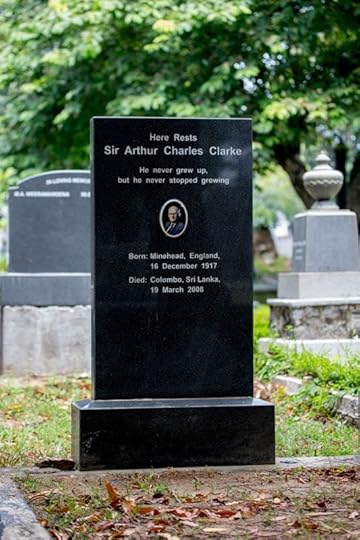
In Colombo, Sri Lanka, lies a cemetery containing the grave of Arthur Charles Clarke who wrote 2001: A Space Odyssey.
The gravestone has this phrase inscribed on it:
“He never grew up, but he never stopped growing”
Arthur C Clarke remained forever young.


By ensuring a growth mindset our companies and ourselves can also attempt to remain forever young.
Our mobile operating system has upgraded itself 18 times in the past 18 years (Apple) or 16 times (Android)
All around us software is constantly updating itself.
How many times have we upgraded our mental operating system in the past 18 years?
Rethought our internal architecture and our API’s on how we connect and perceive and adapt?
After all keeping our bodies in shape is not the same as ensuring our minds are constantly upgrading themselves.
By upgrading our mental operating systems we can remain forever young long after our bodies stop being so.
The lyrics of Forever Young are by Bob Dylan but the best renditions of this song have tended to be by Joan Baez.
Today some of the very powerful and wealthy might benefit from finding ways to rekindle the younger person in them that their older selves may be suppressing.
To remember when idealism, youthful courage and the vivacity of the new idea enabled the possibilities of anything.
Forever Young by Bob Dylan.
May God bless and keep you always
May your wishes all come true
May you always do for others
And let others do for you
May you build a ladder to the stars
And climb on every rung
May you stay forever young
May you stay forever young
May you grow up to be righteous
May you grow up to be true
May you always know the truth
And see the light surrounding you
May you always be courageous
Stand upright and be strong
May you stay forever young
May you stay forever young
May your hands always be busy
May your feet always be swift
May you have a strong foundation
When the winds of changes shift
May your heart always be joyful
May your song always be sung
And may you stay forever young
May you stay forever young

But in many ways we do not remain forever young.
Our bodies give way, our minds lose a step, raw intelligence is replaced by crystalized intelligence and wisdom.
There comes a time to let go, to move on, to climb a second mountain, to pass the baton to a newer generation.
From the main stage to an encore career or a new life.
A different type of growing.
To find a fit where one’s current state of youth is aligned with reality.
Every career and role has a midnight hour and the smart people leave at five to twelve.
When still seen as a prince or princess and not yet a pumpkin.
There are limits to forever young.
And understanding that one can remain forever young, constantly upgrading and having a growth mindset but understanding that is not the same as youth is what the truly forever young understand.
By not overstaying in a role, a point of view, a belief as the world changes is the we we stay…
Forever Young.
June 22, 2025
Creativity in an Age of AI.

In an article for The Verge, Nilay Patel its editor in chief, noted that in an interview with Ben Thompson Mark Zuckerberg described a vision where a client comes to Meta and says “I want customers for my product,” and Meta does everything else. It generates photos and videos of those products using AI, writes copy about those products with AI, assembles that into an infinite number of ads with AI, targets those ads to all the people on its platforms with AI, measures which ads perform best and iterates on them with AI, and then has those customers buy the actual products on its platforms using its systems.
At the recently concluded Cannes International Festival of Creativity, the dominant theme according to all reports was AI. And one of the worries apparently was what AI would do to creativity in a tech infused, data driven, highly measured eco-system dominated by Meta, Google, Amazon and others.
So I thought it would make sense to turn to a gentleman who may know a little about the topic.
His name is Sir John Hegarty and for those not familiar with him here is a little bit to establish his credentials to speak to the subject:
Founder BBH: In 1982, with partners John Bartle and Nigel Bogle, he started Bartle Bogle Hegarty one of the most iconic agencies that helped build brands such as Audi, Levi’s and Johnnie Walker among others.
Awards and Recognition: Sir John has received numerous accolades throughout his career, including the D&AD President's Award, the Cannes Lions Advertising Festival Lifetime Achievement Award, and a knighthood for services to advertising in 2007.
Authored Books: He has written two influential books:
Hegarty on Advertising: Turning Intelligence into Magic
Hegarty on Creativity: There Are No Rules
The Garage Soho: In 2014, he co-founded The Garage Soho, an incubator for disruptive business ideas where he invested in dozens of young companies.
The Business of Creativity: Sir John believes creativity is key to business growth and everyone can nurture creativity. A few years ago he co-founded The Business of Creativity working with companies and leaders all over the world.
You can listen to the entire conversation here and the links at the end of the post.
Here are 4 of many many insights and perspectives Sir Hegarty shared including the single best definition of creativity I have ever heard:
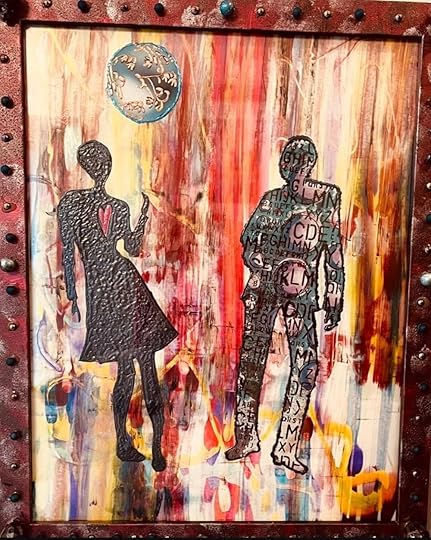 1. Sir John loves and has embraced AI.
1. Sir John loves and has embraced AI.He believes AI is going to be incredible and profound. It will be a significant democratizing opportunity allowing the unleashing of new forms of creativity.
Sir John suggests we should not view AI as a tool but as collaborator that allows all of us to be creative directors. No longer is there an art director or copy writer but the fusion of the two.
The big challenge of AI are the copyright issues and ownership of IP laws.
 2. Creativity is a key to Brands but he is worried that many of today’s brands will fail to endure and are being actively destroyed !
2. Creativity is a key to Brands but he is worried that many of today’s brands will fail to endure and are being actively destroyed !Marketers have become so data driven and so hooked to lower funnel promotion measurable outcomes that significant brand destruction is underway as we have seen with Nike among others.
Brands are not built by promotion but also by persuasion and with the exception of personal brands like influencers very few enduring brands are built online.
Online Brands such as Dollar Shave Club come and go quickly sold to bigger companies who have FOMO. Direct to Consumer brands that depend on metrics and measurement and narrow targeting are mostly eroding because tech companies keep focusing on people who buy the brand or people who look like those who bought the brand which is too narrow and due to competitive bidding for the same people are very expensive to reach.
It is very critical for a brand to be known by those who do not know about it and this is source of growth for most companies. Convincing these folks is not about utility, features and performance but telling a story of what the brand stands for, how it makes one feel, how it resonates with culture, how it fits into a person’s life.
Today brands are being milked and not fed with a focus on the short run.
What is measurable may not be all that matters.
Increasingly smart brands are not only fixating only on online media but are thinking about experience stacks including real world experiences from stores to out of home, immersive media and much more. Out of home grew 8 percent last year !
 3. The Definition of Creativity and why there are two types of Creativity.
3. The Definition of Creativity and why there are two types of Creativity.One day someone told Sir John that the greatest art of all might be music.
Sir John believed it might be the second greatest art for and the greatest of all art is human life.
Human life is an act of creativity.
Sir John defines creativity as follows: Creativity is an expression of self.
Listen to the greatest creative people and you will hear them saying:
“Here is what I wanted to say”
“This is what I wanted to show”
“What I am trying to build”
There are two types of creativity one is pure and the other is applied.
Pure creativity is a spark that leads to the iPhone, creating the Simpsons or designing the Guggenheim in Bilboa. and also drives the greatest iconic works of art, product design and brand building.
Applied creativity is creating the next version of the iPhone, a new episode of The Simpsons or designing the stairs inside the Guggenheim.
Pure creativity is the greatest wealth creator and generator of growth ever.
Creativity drives innovation and the best creativity does not come from A/B testing, mathematics or focus groups.
It feeds on curiosity, instinct, exposure to differing perspectives, feelings and things that do not compute.
This AI versioning is not creativity that builds brands and growth but a smart way to get variations of a theme cost effectively get the lower funnel sale of a Brand that was which was built due to a different form of creativity.
A human creativity of self expression and not a machine variation of optimization and data co-relation.
AI will unleash human creativity but will not replace human creativity.
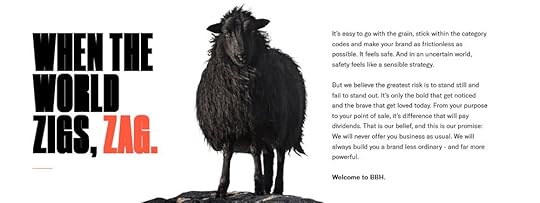 4. Advice to established leaders and young people
4. Advice to established leaders and young peopleSir John has suggested that too many leaders fail to lead.
Lots of arrogance and hubris but basically followers, data clutchers, herd like buzz word bingo chanters.
Leadership is about having courage.
The big leaders step ahead, march to different drummers, take risks on intuition, ideas and instinct.
While Sir John did not mention that they should zig vs others zag I could not mentioning this since the symbol of BBH is the black sheep. If you have not seen what this means check out these ads that defined an era and established valuable profitable brands including Audi, Levi’s, Johnnie Walker and many more.
For young people his advice is to find and do something one loves. Do not just follow the data. Play more. Play is stepping forth with the the lack of rules.
A master class on creativity and thriving as a human in an AI age. Take a listen and you will be moved. Here are Apple and Spotify links but all on podcast platforms globally.
More on Creativity.In the latest The Rethinking Work show an artist and musician turned architect who founded a design firm called FYOOG which is now part of IA one of the world’s largest architectural firm on how to re-imagine space to create meaning, inspire ideas and true interaction. If you want to unleash your team and firms creativity take a look and see spaces that soar and much more. You can watch on YouTube or listen on Spotify or Apple.
And a call for Creative Works!The art work for this issue comes from Britton Bloch who is an artist, studying for her PhD and is Vice President, Global Talent Acquisition Strategy & Head of Recruiting at Navy Federal Credit Union. Britton also reads this thought letter very much like Karin Onsager-Birch another reader whose work was featured last week and Susan Swinand a few months ago. Do you have art, music, video or photography you would like me to feature in this thought letter? If so please send me a note.
June 15, 2025
Trust & Integrity

Most long term successful careers, relationships and lives are built not just on hard work, perseverance, discipline, forgiveness and resilience but also trust and integrity.
Trust enables speed and enables people to take risks on those they trust.
Integrity allows one to gain trust and live in internal and external harmony.
They may not result in fame and fortune but often result in contentment, calmness and comfort in one’s own self.
Gaining trust and living with integrity is difficult since human frailty leads to lapses and mishaps. But it is possible to put into practice habits and approaches that engender trust and allow one to live a life of integrity.
And best of all neither requires money or permission, allowing one to thrive anywhere and at all times by living authentically and with candor.
 Earning Trust
Earning TrustTo earn trust one must be a) clear about intentions, b) show the data, c) be transparent and d) self-correct.
Intentions: If one is not clear about what one is trying to achieve or what our goals are then many people begin to get suspicious. They wonder if there is a hidden agenda or there is some multi-dimensional chess game underway. If we wonder what someone is really trying to achieve it is hard to trust them
Data: In a data driven world how many people are willing to share and show the data on which they are making their decisions or drawing their conclusions? People talk about data but how often do they reveal the facts and figures which how they are coming to conclusions? Show the data versus asking belief in some hidden black box.
Transparency: In addition to clarity of intentions and the access to data it is necessary to be transparent on the process which leads to a recommendation or perspective. One needs to share not just the dish (goal) being prepared and the ingredients (data) but the process (recipe) of combining and turning the ingredients into the dish. This allows people to interrogate and also correct wrong recommendations by identifying where one’s goals, or one’s data or one’s thinking can be enhanced or improved.
Self-Correction: To be human is to err. So often one makes mistakes. A key part of keeping and gaining trust is correcting mistakes, clarifying miscommunications and adjusting one’s behaviors. Often it is how one reacts to something that goes wrong that earns trust than if things did not go wrong.
 Achieving Integrity
Achieving IntegrityIntegrity is achieved when what one says, one believes and one does are aligned and also consistent with the realities of science and economics.
Clearly there are many times that what we say, what we believe and what we do may not be consistent.
Words, thoughts and actions may not align all the time.
It could be as simple as a white lie where not to hurt another’s feelings we hold our tongue.
Or it could be that we cannot afford to lose our job or endanger a relationship that we end up saying one thing while believing another or doing things not aligned with belief.
But over time a disparity between thought, belief and action leads to an internal corrosion, a draining of agency and is rarely the recipe for long term success.
It makes one insecure, hesitant and reduces the likelihood of success.
We end up living in other people’s minds where external aspirations are disconnected from an internal motivations. By following the wrong star home we our lose the way.
But aligning words, belief and action is not enough to live a life of integrity since life occurs in the real world where the rules of science and economics prevail in the long run.
We can say you we not believe in gravity and we can jump out of the window of a high floor. This aligns words, beliefs and actions but it also leaves us dead.
Or we can truly want to provide help to people, say so and do so but soon we or our companies will grow broke since someone has to create value and build resources before we allocate them away. Supply and demand, incentives of self interest and market economics always end up prevailing.
Words, beliefs and actions aligned with reality of science and economics is the way to achieve integrity.
Art by Karin Onsager-Birch a reader of this thought letter. More about Karin here .
June 8, 2025
The Rethinking Work Show
Work is central to the human experience and along with health and relationships is a key to happiness.
Work is in the midst of the greatest change in decades and is expected to change more between 2020 and 2029 than it has in the past five decades,
This change is driven by five intertwined forces including 1) demographic shifts of declining and aging populations as well as multiple generations with different mindsets, 2) technological changes including AI, 3) the rise of marketplaces such as Shopify, 4) new types of working where free-lance employment is overtaking full-time employment and 5) the long term implications of Covid on not just where one works but who one works for and why one works.
Four months ago my book Rethinking Work was published in the US and India and is now available in the UK and a few other countries in print and everywhere also as an Audible or Kindle download. The book is filled with blueprints and frameworks and steps every individual, leader and team can utilize anywhere in the world to thrive rather than be surprised with what is coming.
The book has resonated not just with individuals trying to prepare and be forewarned and forearmed as jobs decline but work opportunities rise but also by CEO’s who realize that as every aspect of work shifts the strategies and organizational designs of their have to reinvented in a hurry.
Universities have taken to the book to prepare students for the new work places, and HR societies including SHRM have had me discuss how this is the best and worst time for HR and Learning and Development teams. The best of times because training, organizational design and leadership rethinking will be central but the worst of times because it will require HR to reinvent itself first and fast for a world where employees will both be human and ai, where most workers will not be full time employees and in fact most of the work force will not just work from anywhere but in completely new ways.
Recently I spoke with the leadership of a major company and they asked that since it had been a year since I last edited the book what had I got wrong?
One thing.
Things are moving much faster than I anticipated.
The last five chapters of my book describe what companies will look like in 2029 and the specific changes every individual and firm should prepare for. Because of AI doubling in capability every 7 months vs 12 months when I wrote the book, as well as other shifts, I expect the new world order to happen by the end of 2027.
To better illuminate, illustrate and inspire people to re-imagine the incredible world of work I launched a YouTube show earlier this week ( also available as a podcast on Apple and Spotify) called The Rethinking Work Show where the best people in the world from CEO’s to Academics to HR leaders to Architects to Technologists to Entrepreneurs will share their best learnings from all over the world.
Ria Tobaccowala our elder daughter who is an accomplished film maker is side-gigging a project for her dad and has plans to make this far more visually and well produced but we had to get started and then begin refining.
If you watch (or listen) to the first episode where I speak with Raj Choudhury of Harvard Business School and the author of the recently released book “The World is Your Office” you will see what we are aiming at. Basically amazing people with data backed perspectives to help each of us completely rethink where work is going.
Like this Substack and my podcast What Next? the show is a gift with no cost and no advertising.
Episode 1: Work From Anywhere.

Here are some of the key points made by Dr Choudhury:
1. The future will be work from anywhere (where one chooses where one want to live ) which is even more flexible than remote and hybrid. Data shows that it is allowing companies to hire the best talent, replace fixed costs with variable costs, and align with the AI age where digital twinning and generative AI will turbocharge knowledge sharing, asynchronous work and bring work and factory to the person versus the person to the work.
2. Despite the headlines of companies insisting people return to work the real flow is in the opposite direction. Research does not prove that RTO changes a companies success metrics but it does result in a 10 percent attrition which is probably what most companies are trying to do ( reduce head count without severance). In fact there is data that the more flexible companies are growing faster and more flexibly!
3. In the episode Dr Choudhury shares case after case all over the world from Unilever in Brazil, to Power Companies in Turkey to Hospitals in New York where digital twinning is separating location from expertise as well as companies.
4. We discuss the three pushbacks that work from anywhere enthusiasts need to deal with which are knowledge sharing, communication and culture and every one of these are turned on their head. For instance research shows that unless you work within 75 feet of somebody all this serendipity of water cooler conversations will not happen. Today with generative AI knowledge sharing is no longer an issue and we will all have little Yoda’s and ET’s to talk with. Also in most cases communication that is asynchronous allows for more diverse perspectives, better ideas and deep thinking. Just take a listen and you will forever think differently.
5. Most importantly Dr Choudhury shows how firms do not have to go all in on a new way of working but shows how companies can phase in different ways of working which need to be customized for different teams. The key is a one size fits all model that many companies are trying is probably the worst of all worlds.
In less than 40 minutes you will come away different. Take a listen to Episode 1. Subscribe and every week there will be another world class person providing you ways to truly grow and transform and rethink work.
The Rethinking Work Show can also be streamed as a podcast on Apple or Spotify
Here is Apple:
Here Spotify:
All the ways and places you can get the book: https://rethinking-work.io/whats-inside-2

June 1, 2025
Ruptures in the Mediascape: What Next?

Photography by Reuben Wu
Over four years ago, I published a post called Ruptures in the Mediascape which correctly anticipated 1) the rising importance of commerce media like Walmart.Com and Amazon, 2) The massive influence and rising impact of podcasts, 3) TikTok’s exponential growth, 4) the renaissance in Out of Home Media 5) the likelihood that Meta would find a way around Apple’s privacy initiatives and 6) how creator and influencer media would eclipse traditional media.
The one thing I got wrong was the belief that the major streaming platforms would remain ad-free by failing to anticipate how expensive they would get without ads due to multiple price increases and the crack down on sharing passwords. Today the ad supported tiers are the same price as the ad free tiers were four years ago!
So What Next?
I believe we are now going to see ruptures that are far more significant and deeper happening between now and the end of next year, which will require every business not just those in the media and marketing space to re-imagine many aspects of their products, services and go to market strategies.
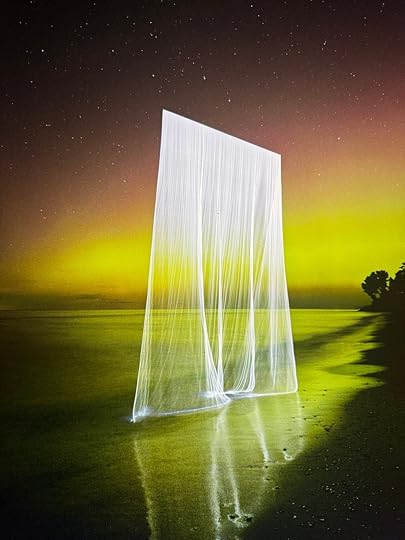
Photography by Reuben Wu
Here are 6 shifts in the mediascape already underway and their implications:
1. The Rise of Poetry versus Plumbing: For the past two decades digital media has primarily been built on advances in infrastructure or plumbing to find the right person at the right person at the right time. The point of contact has been enhanced but the content which is the interaction, creative or messaging has not been as customized or personalized due to the high cost of doing so.
Today, with a plethora of new tools like Veo 3, Sora, Runway ML, Suno, Mid-Journey and others we will see a renaissance of customized creativity. The Poetry that builds brands and resonates with hearts and minds will now match the Plumbing that enhances relevance by finding the right eyes and ears at the most appropriate time.
For many years media was a second class citizen and then came to dominate agencies and service providers. Media will continue to remain critical but creativity and story-telling will move from the caboose to the front of the train too.
2. Conversation the third Interface: Today, two interfaces dominate media particularly digital media: Search and Streams. These will be joined by a third which is Conversations. Whether it be the back and forth with Chat, next generation messaging or Agents interrogating and driving outcomes we will see conversations become a key interface which will also further the rise of voice as an input device besides typing and finger swiping.
Some of these conversations will be about relationships ( today the most popular AI apps are where people look to AI for relationships or growth) and the next CRM will use variations of these conversation interfaces while many conversations will be about getting answers.
One of the reasons Search Engine Marketing works is because Search does not.
If we got the answer we were looking for would we hunt and peck across a sea of links? Companies and interfaces are going to have to be answer optimized.
My friend Pete Blackshaw, the founder and CEO of Brandrank.Ai posits that SEO ( Search Engine Optimization ) will be replaced with AEO ( Answer Engine Optimization)
3. Anticipation the step beyond Personalization: Combine the ability to customize creativity and messaging with the ability to surface answers in real time and the persona based research enabled by AI and the best marketing will not just personalize but anticipate what one needs when one needs it.
In addition to the first moment of truth and then the zero moment of truth movements in marketing we are now going to hear about the minus one moment of truth where the best anticipator will win over the best personalizer.

Photography by Reuben Wu
4. The rise of the Experience Stack: The new marketing stack will combine real, digital, immersive, virtual and mixed experiences to anticipate needs and create impactful storytelling, commerce and services. The real will be the physical world including events, concerts, out of home and physical stores, the immersive will incorporate gaming and interactions such as the Sphere in Las Vegas, the digital will incorporate the next generation of today’s open and closed web and apps, while the virtual will include VR and spatial computing such as Oculus and Vision Pro and mixed experiences will be built around AR glasses from Meta, and AI/XR glasses and Project Astra from Google.
The trick will be to combine these experiences in ways that anticipate, allow for conversations and answers while delivering interactions that win hearts and minds.
5. Platforms become Outcome Engines: In a recent conversation with Ben Thompson which is worth a read Mark Zuckerberg spells out one of his visions for Meta as follows:
A client comes to Meta and says “I want customers for my product,” and Meta does everything else. It generates photos and videos of those products using AI, writes copy about those products with AI, assembles that into an infinite number of ads with AI, targets those ads to all the people on its platforms with AI, measures which ads perform best and iterates on them with AI, and then has those customers buy the actual products on its platforms using its systems.
Mark said the quiet part loud but that is the model with which the supposed decline in search engine marketing revenue for Google is offset. Google combines You-Tube, AI mode of search, Google Lens, Gemini, Project Astra, Project Mariner, Flow and more to drive outcomes not just search results or contextual advertising. Play around at Google Labs and you can imagine these great tools leveraged by the marketing and engineering talent they have collected over the years to drive outcomes: https://labs.google/
It will not just be Google and Meta but also Amazon and Walmart and many others that will morph from platforms to outcome engines.
6. Brands will continue to matter but will be built and sustained in new ways through a fusion of carbon based humanity driven emotional levers combined with next generation mathematics and technology: People choose with their hearts and use numbers to justify what they just did.
Without a person’s need to belong, stand out, aspire, be inspired and story tell there would be no brands. If all that was needed was a superior product at a fair price there would really be no need for brand marketing. A brand is far more than the utility of the product but also involves desire, provenance, design, storytelling and much more.
A brand has been a trust mark that stands for a promise. A brand is about integrity where what the brand delivers, what a brand says and what a brand believes are aligned. A brand is about a story of the product, the buyer, the culture around it and more.
In an AI age Trust, Integrity, Story-telling, Cultural resonance will matter but will be architected, honed and sculpted using conversations, anticipation, experience stacks, outcome engines and most importantly poetry and not just plumbing.
And it will not just be the tech but the talent, the taste, the voice, the touch and the not yet imagined that will create and sustain the next generation of great brands.
But every company needs to interrogate themselves on the products and services they can create or sustain which complements or supplements outcome engines. What value can we add in addition to those of outcome engines?
We should ask if we have the right talent, urgency, partners and organizational structure to navigate experience stacks and remain relevant in a world where every product will also be a service due to conversation and agent technologies.
The future while uncertain is coming fast and definitely will not fit in the containers most incumbent companies have designed for today…
This is the 251st edition of The Future does Not Fit Into the Containers of the Past Substack. Here is a single page with access to the 100 best pieces written over 12 different subject areas including The Future, Managing Change, Upgrading Our Mental Operating System, Selling Better, Building Cultures, Managing Careers, Wisdom and much more. All completely free and read by 30,000 executives. https://Rishadtobaccowala.com/100
May 25, 2025
The Future Fits on One Page.
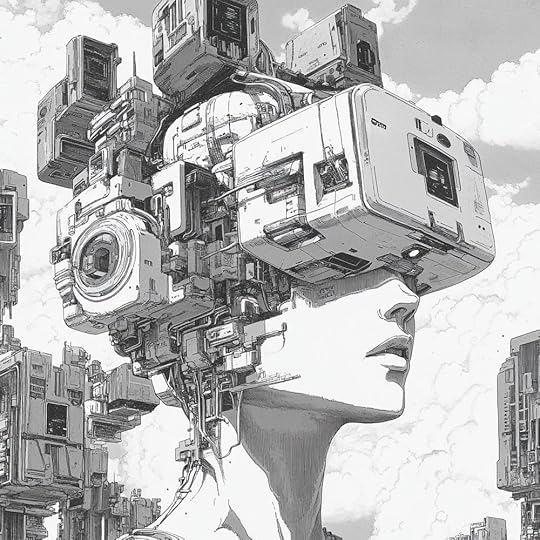
This is the 250th edition of “The Future Does Not Fit in The Containers of the Past”
Published every single Sunday morning for 250 weeks at around 8 am Chicago time.
The first edition of this thought letter was published on August 16, 2020 began like this…
Welcome to my first issue of “The Future Does Not Fit in The Containers of the Past” newsletter. Thank you for subscribing.
What I hope you will get from this newsletter
The idea behind this newsletter is that of a gift.
Like a gift it is free (no subscription fee, no up-charges to access special content, no advertising, no affiliate links, your email will not be shared or sold, and no algorithm is running in the background mining your behavior)
Like a gift I hope it will be of some value in helping you see, feel and think differently about how to grow yourself, your team and/or your company in the future.
Like a gift, I hope it will generate goodwill for the giver. Your attention and time which is so valuable. Good karma. Stronger relationships.
This newsletter will be bohemian and eclectic in that it will mix art and science, it will have a certain wanderlust and will roam into different areas…
Today nearly five years later more than 350,000 words or nearly 7 books of content have been written and shared. Subscribers have grown from 500 to nearly 30,000. The thought letter has remained completely free of monetization. And the range of topics have wandered far and wide with the writing steering away from only from politics and news.
In keeping with the gifting orientation that drives this thought letter I have curated the best 100 pieces of writing and organized them into 12 areas which are now all accessible from a single page here or at https://rishadtobaccowala.com/100
I provide an overview of the sections and the best pieces below. But first here are the five most popular pieces over the past five years listed in order which indicate the range of the writing.
Re-thinking Presentations. by Rishad Tobaccowala
The Future Does Not Fit in the Containers of the Past. Edition 55.
Read on SubstackSmall Things. by Rishad Tobaccowala
The Future Does Not Fit in the Containers of the Past. Edition 195.
Read on SubstackA Company of One. by Rishad Tobaccowala
The Future Does Not Fit in the Containers of the Past. Edition 155.
Read on SubstackRe-Invented Marketing: 5 Shifts. by Rishad Tobaccowala
The Future Does Not Fit in the Containers of the Past.Edition 241.
Read on SubstackAvoiding Career Irrelevance. by Rishad Tobaccowala
The Future Does Not Fit in the Containers of the Past. Edition 223.
Read on Substack The 12 Areas of Writing1. The Future: Here are articles on The Four Shifts that are driving the future, a series of pieces on Why AI is Under-hyped, How to remain relevant in an AI age and How to Upgrade our AI quotient as well as Ten Forecasts for the Next Decade and how to avoid Strategic Myopia.
2. Managing Change: To manage change in ways that suck less we need to follow the 6 Keys to Change while curing ourselves of Inner Dinosaur Disease and learn to Think Like an Immigrant.
3. Upgrading our Mental Operating Systems: Our phones have upgraded their operating systems in the last 18 years how many time have we? This section shares how to be better at Learning to Learn, How to Think Better, and how it is key to think from Both Sides Now.
4. Enhancing Effectiveness: So much of our lives our spent attending meetings. What if everything we have been told about how to be effective in these areas are wrong? Rethinking Meetings shows how we do not attend meetings but stare-a-thons and most of given advice on how to run meetings are wrong! Understand the importance of Tattoo Moments and why Fewer is better.
5. Becoming A Leader: In an Age of De-bossification here are Four Keys to Leading Today and 8 Management Lessons from some great leaders.
6. Rethinking Media, Marketing and Creativity: In a single graphic the last four decades of change in marketing and where it is going are shared in Re-Invented Marketing: Five Shifts. A very popular piece was on why the Future of Marketing is People and how we are entering an Age of Creativity.
7. Selling Better: To close more sales it is key to understand the 8 Things Customers Want, why one must spend time Rethinking Presentations and how Small Things matter and every time one wants to sell one must frame and filter using S.A.V.E.
8. The Future of Work: A series of articles which foresaw the world we live in today including why we are living in Career Bending Times and how most companies could get Returning to the Office right.
9. Creating Great Cultures and Future Forward Organizations: What are the key components of Cultures. Why it is important to call out The Turd on the Table, to combine Roots and Wings and recognize that Generosity is a Strategy.
10. Managing Careers: How do we thrive in a world of Fifty Year Careers where we are going to see the Decline of Jobs. The Rise of Work. The key exercise for Career Turbocharging and all the lessons of a Career Revisited and why everyone must learn to work like a Company of One.
11. Personal Growth: We become who we are through Chances, Changes and Choices, learning the importance of Repairing Ourselves, finding times to go Vagabonding and learning the limits of things in On Stuff
12. Wisdom: We chase after it but what can we learn about Architecting Joy, find Grace, the importance of Appreciation and how life is about Loss, Love and Learning.
You can find all these pieces and much more available completely free to use and leverage as you like all accessible from a single page here or at https://rishadtobaccowala.com/100
Thank you for being a reader.
Your time is rare and therefore your attention is a gift.
If you ever wanted to introduce this writing to others this might be the ideal post to share.
...

This is the 250th edition of “The Future Does Not Fit in The Containers of the Past”
Published every single Sunday morning for 250 weeks at around 8 am Chicago time.
The first edition of this thought letter was published on August 16, 2020 began like this…
Welcome to my first issue of “The Future Does Not Fit in The Containers of the Past” newsletter. Thank you for subscribing.
What I hope you will get from this newsletter
The idea behind this newsletter is that of a gift.
Like a gift it is free (no subscription fee, no up-charges to access special content, no advertising, no affiliate links, your email will not be shared or sold, and no algorithm is running in the background mining your behavior)
Like a gift I hope it will be of some value in helping you see, feel and think differently about how to grow yourself, your team and/or your company in the future.
Like a gift, I hope it will generate goodwill for the giver. Your attention and time which is so valuable. Good karma. Stronger relationships.
This newsletter will be bohemian and eclectic in that it will mix art and science, it will have a certain wanderlust and will roam into different areas…
Today nearly five years later more than 350,000 words or nearly 7 books of content have been written and shared. Subscribers have grown from 500 to nearly 30,000. The thought letter has remained completely free of monetization. And the range of topics have wandered far and wide with the writing steering away from only from politics and news.
In keeping with the gifting orientation that drives this thought letter I have curated the best 100 pieces of writing and organized them into 12 areas which are now all accessible from a single page here or at https://rishadtobaccowala.com/100
I provide an overview of the sections and the best pieces below. But first here are the five most popular pieces over the past five years listed in order which indicate the range of the writing.
Re-thinking Presentations. by Rishad Tobaccowala
The Future Does Not Fit in the Containers of the Past. Edition 55.
Read on SubstackSmall Things. by Rishad Tobaccowala
The Future Does Not Fit in the Containers of the Past. Edition 195.
Read on SubstackA Company of One. by Rishad Tobaccowala
The Future Does Not Fit in the Containers of the Past. Edition 155.
Read on SubstackRe-Invented Marketing: 5 Shifts. by Rishad Tobaccowala
The Future Does Not Fit in the Containers of the Past.Edition 241.
Read on SubstackAvoiding Career Irrelevance. by Rishad Tobaccowala
The Future Does Not Fit in the Containers of the Past. Edition 223.
Read on Substack The 12 Areas of Writing1. The Future: Here are articles on The Four Shifts that are driving the future, a series of pieces on Why AI is Under-hyped, How to remain relevant in an AI age and How to Upgrade our AI quotient as well as Ten Forecasts for the Next Decade and how to avoid Strategic Myopia.
2. Managing Change: To manage change in ways that suck less we need to follow the 6 Keys to Change while curing ourselves of Inner Dinosaur Disease and learn to Think Like an Immigrant.
3. Upgrading our Mental Operating Systems: Our phones have upgraded their operating systems in the last 18 years how many time have we? This section shares how to be better at Learning to Learn, How to Think Better, and how it is key to think from Both Sides Now.
4. Enhancing Effectiveness: So much of our lives our spent attending meetings. What if everything we have been told about how to be effective in these areas are wrong? Rethinking Meetings shows how we do not attend meetings but stare-a-thons and most of given advice on how to run meetings are wrong! Understand the importance of Tattoo Moments and why Fewer is better.
5. Becoming A Leader: In an Age of De-bossification here are Four Keys to Leading Today and 8 Management Lessons from some great leaders.
6. Rethinking Media, Marketing and Creativity: In a single graphic the last four decades of change in marketing and where it is going are shared in Re-Invented Marketing: Five Shifts. A very popular piece was on why the Future of Marketing is People and how we are entering an Age of Creativity.
7. Selling Better: To close more sales it is key to understand the 8 Things Customers Want, why one must spend time Rethinking Presentations and how Small Things matter and every time one wants to sell one must frame and filter using S.A.V.E.
8. The Future of Work: A series of articles which foresaw the world we live in today including why we are living in Career Bending Times and how most companies could get Returning to the Office right.
9. Creating Great Cultures and Future Forward Organizations: What are the key components of Cultures. Why it is important to call out The Turd on the Table, to combine Roots and Wings and recognize that Generosity is a Strategy.
10. Managing Careers: How do we thrive in a world of Fifty Year Careers where we are going to see the Decline of Jobs. The Rise of Work. The key exercise for Career Turbocharging and all the lessons of a Career Revisited and why everyone must learn to work like a Company of One.
11. Personal Growth: We become who we are through Chances, Changes and Choices, learning the importance of Repairing Ourselves, finding times to go Vagabonding and learning the limits of things in On Stuff
12. Wisdom: We chase after it but what can we learn about Architecting Joy, find Grace, the importance of Appreciation and how life is about Loss, Love and Learning.
You can find all these pieces and much more available completely free to use and leverage as you like all accessible from a single page here or at https://rishadtobaccowala.com/100
Thank you for being a reader.
Your time is rare and therefore your attention is a gift.
If you ever wanted to introduce this writing to others this might be the ideal post to share.



